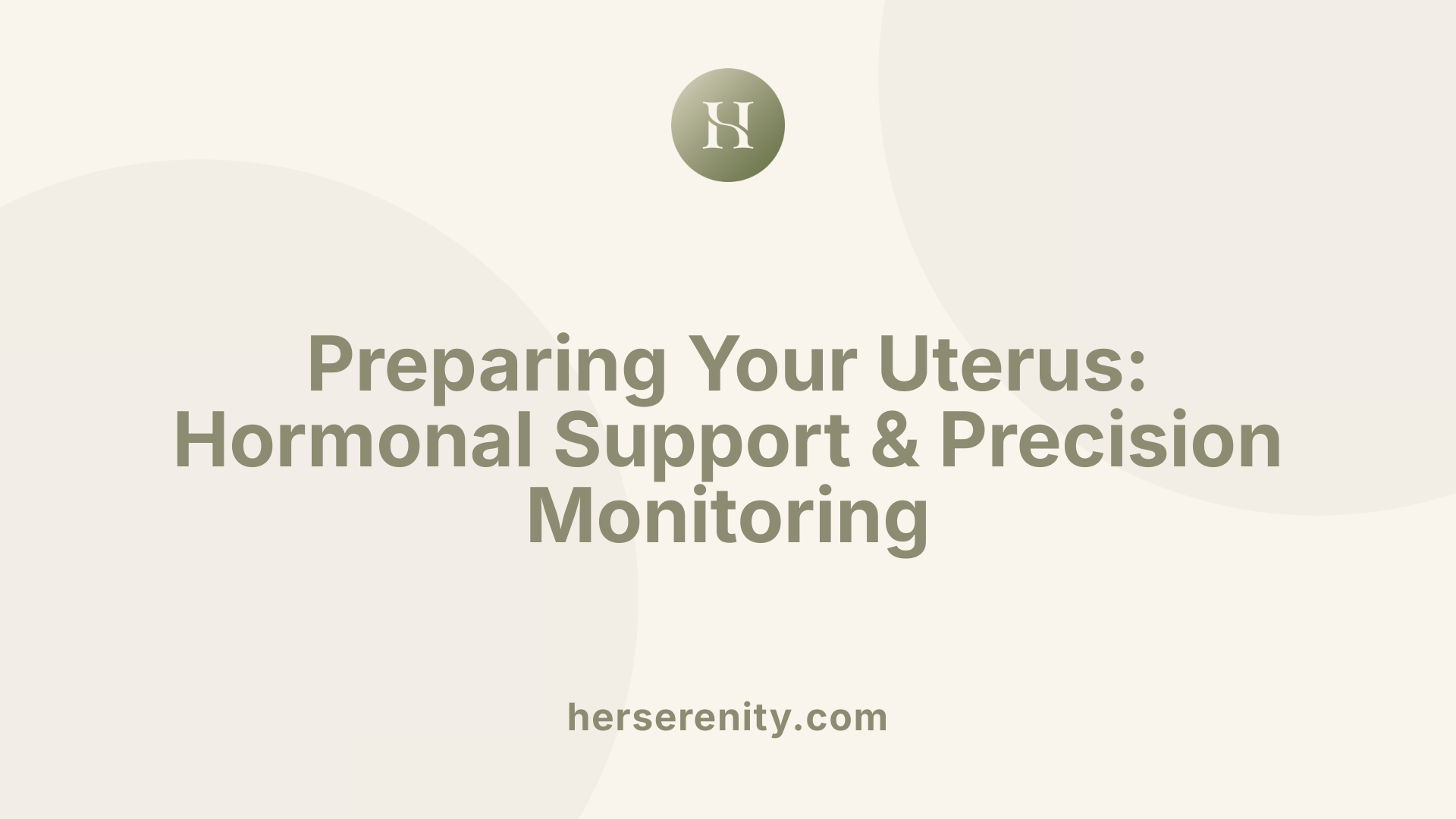Introduction to Embryo Implantation Optimization
Embryo implantation is a critical step in assisted reproductive technology (ART), and multiple factors influence its success. From the health of the uterine lining to lifestyle choices, understanding and optimizing these elements can significantly improve IVF outcomes. This article explores scientifically backed strategies, procedural advancements, and supportive practices to maximize the chances of successful embryo transfer.
The Significance of Endometrial Health in IVF Success
Supporting the growth and function of the endometrial lining
A healthy endometrial lining is vital for successful embryo implantation during IVF. Optimizing the lining involves ensuring it is thick enough—generally around 7mm or more—to create a welcoming environment for the embryo. This is achieved through diligent medication protocols, lifestyle choices, and sometimes through advanced therapies like PRGF or endometrial scratching.
Proper support includes managing hormone levels with estrogen and progesterone, which prepare the uterus after ovarian stimulation or natural cycles. Monitoring uterine lining thickness through ultrasound helps guide adjustments and confirms readiness for embryo transfer.
Nutrients, circulation, and microbiome impact
The health of the uterine environment depends considerably on nutrient status, blood circulation, and the reproductive tract microbiome. Nutrient-rich diets, such as the Mediterranean diet, supply antioxidants, healthy fats, and fiber that support tissue regeneration and blood flow. Adequate circulation delivers oxygen and nutrients essential for lining growth.
Emerging research highlights the role of the uterine microbiome—the community of microorganisms within the uterus—in implantation success. Maintaining a balanced microbiome through diet, probiotics, and avoiding unnecessary antibiotic use can foster an optimal environment.
In addition, avoiding endocrine disruptors like plastics and synthetic fragrances can protect hormonal balance, supporting endometrial receptivity. Regular moderate exercise and acupuncture are also beneficial in promoting circulation and reducing stress, further enhancing endometrial health.
A combination of proper nutrition, lifestyle, and advanced medical support can significantly improve the conditions necessary for embryo implantation. When the endometrium is optimally prepared, the chances of IVF success increase markedly, especially in women with a history of poor lining development or repeated failed transfers.
Prepping the Uterus: Hormones, Techniques, and Monitoring

What preparations, procedures, and post-transfer actions can maximize IVF success?
Maximizing the chances of a successful IVF cycle involves several carefully planned steps focused on preparing the uterus and supporting early pregnancy. Before the embryo transfer, patients often undergo hormonal treatment to optimize the uterine lining. Estrogen therapy helps thicken the endometrium, while progesterone is used to support its receptivity and maintain the pregnancy environment.
Monitoring the endometrial lining through ultrasound is crucial. Healthcare providers typically measure the thickness of the uterine lining during the cycle, aiming for at least about 7mm, which is associated with better implantation rates. Ultrasound guidance during embryo transfer itself enhances placement accuracy, greatly increasing the likelihood of successful implantation.
The embryo transfer procedure is minimally invasive and quick, often guided by ultrasound to ensure precise embryo placement into the uterus. To support this delicate process, some clinics administer additional substances like hyaluronic acid, which can help improve embryo adhesion. Use of specialized techniques such as assisted hatching or embryo selection methods may further improve success chances.
Post-transfer actions are equally important. Patients are advised to follow specific medication schedules, especially continuing progesterone and estrogen support as prescribed. Rest and avoiding strenuous activities or infections are recommended to create a calm environment for implantation. Emotional support, stress management, and maintaining a healthy lifestyle—including proper sleep, moderate exercise, and a nutrient-rich diet—are vital.
Adequate hydration and avoiding harmful substances such as alcohol, tobacco, and endocrine disruptors also contribute to optimal conditions. Ongoing communication with medical providers ensures that any concerns are promptly addressed, and adjustments made if needed.
In summary, combining hormonal support, precise ultrasound-guided transfer, and dedicated post-procedure care creates the best environment possible for embryo implantation and pregnancy success.
Lifestyle and Diet for Reproductive Optimization
How can lifestyle, diet, and supportive practices influence implantation success during IVF?
Optimizing lifestyle and dietary habits can significantly improve the chances of successful embryo implantation during IVF. A nutritious, balanced diet rich in whole foods, antioxidants, and essential nutrients helps maintain hormonal balance and supports overall reproductive health. Incorporating foods like fruits, vegetables, lean proteins, healthy fats, and high-fiber carbohydrates creates an environment conducive to embryo development.
Achieving and maintaining a healthy weight, typically a BMI between 18.5 and 24.9, is associated with higher pregnancy rates. Both underweight and overweight statuses can impair hormonal function and reduce IVF success.
Stress management techniques—including mindfulness, meditation, and emotional support—help mitigate the negative effects of stress on fertility. Practices like yoga, Tai Chi, and moderate walking improve blood circulation and reduce stress hormones, contributing to a healthier uterine environment.
Avoiding harmful substances is crucial. Smoking, excessive alcohol consumption, and high caffeine intake are linked to lower fertility and reduced implantation chances. Limiting caffeine to 1-2 cups daily and abstaining from alcohol altogether around embryo transfer can provide a supportive environment for implantation.
Supplements such as folic acid, vitamin D, omega-3 fatty acids, and CoQ10 have been shown to support egg quality and embryo viability. Ensuring adequate sleep—ideally 7-9 hours a night—further balances hormonal rhythms and enhances fertility.
Minimizing exposure to environmental toxins like plastics, synthetic fragrances, and household chemicals (such as phthalates and parabens) helps preserve hormonal health. Using natural skincare and household products can reduce the burden of endocrine disruptors.
In summary, adopting a healthy, balanced lifestyle with proper diet, stress reduction, and avoidance of harmful chemicals creates a favorable setting for embryo implantation, increasing the likelihood of IVF success. This holistic approach, combined with patience and positivity, supports both physical and emotional well-being during the fertility journey.
Scientific and Natural Methods to Improve Embryo Implantation
Embryo implantation success depends on multiple biological processes, including hormonal balance, molecular signaling pathways, autophagy, and the composition of the extracellular matrix.
One fundamental aspect is optimizing hormonal levels, especially keeping ovarian estrogen and progesterone within ideal ranges. These hormones prepare the uterine lining, making it receptive for embryo attachment. Proper hormonal regulation is essential for synchronizing the embryo’s arrival with a receptive endometrium.
Molecular signaling plays a vital role in establishing a hospitable uterine environment. Key factors such as Leukemia Inhibitory Factor (LIF), Heparin-binding EGF-like growth factor (HB-EGF), Bone Morphogenetic Protein 2 (BMP2), and Wnt proteins coordinate cellular processes like decidualization—the transformation of the endometrial lining—and embryo attachment. Ensuring these molecules are properly expressed enhances the chances of successful implantation.
Autophagy, the cell's degradation and recycling process, also contributes to the uterine environment. Promoting autophagy can improve uterine receptivity. Pharmacological agents such as rapamycin, or natural compounds like berberine and emodin, are shown to regulate autophagy positively, potentially leading to better implantation outcomes.
Furthermore, the extracellular matrix (ECM)—a network of proteins like collagen that support and organize tissue—must be adequately remodeled. Techniques such as localized collagenase-1 treatment can influence ECM composition, facilitating angiogenesis and increasing vascular permeability. This remodeling creates a more welcoming environment for the embryo.
Combining these scientific approaches with healthy lifestyle choices can further improve success rates. Reducing stress, avoiding smoking and excessive alcohol, maintaining a balanced diet rich in fertility-supporting nutrients, and ensuring proper sleep all contribute to a conducive environment for embryo development.
In sum, both natural and scientific interventions targeting hormonal, molecular, cellular, and structural aspects of the uterus can enhance the likelihood of embryo implantation, supporting couples in their path to pregnancy.
Optimizing Embryo Transfer Techniques for Better Outcomes

What specific actions should be taken before embryo transfer to improve success rates?
Preparing properly for embryo transfer is crucial for increasing the chances of a successful pregnancy. Patients should diligently follow all medical instructions, including taking prescribed hormonal support such as estrogen and progesterone consistently on schedule. These medications help optimize the uterine lining, making it receptive to implantation.
Maintaining a healthy lifestyle enhances the environment for embryo transfer. This includes eating a balanced diet rich in fruits, vegetables, healthy fats, and whole grains, staying well-hydrated, managing stress through techniques like meditation or acupuncture, and ensuring adequate sleep of 7-9 hours nightly.
On the day of the transfer, arriving with a full bladder can enhance ultrasound visualization and make the procedure more comfortable. The transfer itself is quick, usually lasting about 15-30 minutes, and typically painless when ultrasound guidance is used.
In the case of frozen embryo transfers, monitoring the uterine lining’s thickness is important. A lining of at least approximately 7mm is considered ideal. Supporting embryo quality may involve advanced techniques such as preimplantation genetic testing (PGT) or time-lapse embryo monitoring.
After the procedure, patients are advised to rest and avoid vigorous activities, sexual intercourse, or putting anything in the vagina for a few days to reduce infection risks. Continuing prescribed medications like estrogen and progesterone is vital to support early pregnancy.
Overall, combining proper medication adherence, lifestyle modifications, and precise procedural techniques—such as using ultrasound guidance and appropriate catheter type—can significantly improve embryo implantation success.
What about the technical elements of the transfer?
The choice of catheter and the use of supportive substances like hyaluronic acid also influence outcomes. Using a soft catheter instead of a hard one has been associated with higher pregnancy rates. Additionally, administering hyaluronic acid directly during the transfer has been shown to improve implantation chances.
Ensuring the embryo is placed accurately into a receptive and prepared uterine environment is the goal. Techniques like ultrasound-guided placement increase the likelihood of precise embryo positioning, further supporting successful implantation.
Addressing Embryo Transfer Failures and Strategies to Improve Success
Embryo transfer failure can be distressing for couples undergoing fertility treatment. Understanding common causes helps in developing effective strategies to enhance success rates.
One significant factor is embryo quality. Embryos with chromosomal abnormalities, such as aneuploidy, are more likely to fail implantation. These abnormalities become more frequent with maternal age. Preimplantation genetic testing (PGT), including PGT-A, allows for the selection of genetically normal embryos, thereby improving the chances of successful implantation.
Uterine factors also play a critical role. Conditions like fibroids, polyps, endometriosis, or inflammation can impair the uterine environment. Diagnostic procedures such as hysteroscopy help identify these issues, which can often be corrected surgically to create a receptive uterine lining. Ensuring the endometrial thickness reaches at least around 7mm is important for implantation.
Sperm quality, specifically DNA integrity, influences embryo development. Advanced sperm selection techniques like IMSI and HA ICSI are used to choose the best sperm, enhancing embryo quality.
Lifestyle choices have a notable impact. Smoking, excessive alcohol, obesity, and high stress levels can decrease fertility and reduce the likelihood of embryo implantation. Making lifestyle modifications—such as quitting smoking, limiting alcohol, maintaining a healthy weight, and managing stress—can significantly improve outcomes.
Technical improvements during embryo transfer, including ultrasound guidance and using a soft catheter, increase the chances of successful implantation. Protecting the embryo with supportive measures like special media containing hyaluronan can further enhance success.
Additionally, ensuring hormonal support with medications like estrogen and progesterone, and monitoring endometrial receptivity, align the uterine environment for optimal adhesion.
By focusing on embryo health, uterine condition, lifestyle factors, and technical precision during transfer, fertility specialists aim to minimize failures and boost the likelihood of pregnancy.
Comparing Natural and Medicated Frozen Embryo Transfers
 When considering frozen embryo transfer (FET) procedures, two main cycle types are available: natural cycle FET and medicated cycle FET. Understanding the differences between them can help individuals and their healthcare providers choose the most suitable approach.
When considering frozen embryo transfer (FET) procedures, two main cycle types are available: natural cycle FET and medicated cycle FET. Understanding the differences between them can help individuals and their healthcare providers choose the most suitable approach.
What is the role of natural cycle frozen embryo transfer and how does it compare to medicated cycles?
Natural cycle FET (NC-FET) utilizes a woman’s own hormonal rhythm to prepare the uterine lining. This method involves closely monitoring ovulation through blood tests and ultrasounds, with the transfer scheduled approximately five days after ovulation. Sometimes, an hCG injection is used to induce ovulation if it does not occur spontaneously. Since NC-FET relies on natural ovulation, it typically involves minimal or no hormone medications, making it a gentler option that reduces exposure to synthetic hormones and potential side effects.
Medicated FET cycles, on the other hand, involve administering hormones such as estrogen and progesterone through pills, patches, or injections. This approach allows precise control over the timing of the endometrial lining’s development, ensuring optimal preparation for embryo transfer regardless of the woman’s natural cycle. It offers benefits in terms of predictability and scheduling flexibility, which can be advantageous in a busy clinic setting.
How do success rates compare?
Studies show that both natural and medicated FET cycles have comparable pregnancy and live birth rates. However, some research suggests slight variations depending on individual health and cycle characteristics. The predictability and control offered by medicated cycles often make them the preferred choice for women with irregular cycles or other reproductive health issues.
Who is suitable for each approach?
Choosing between natural and medicated FET depends on numerous factors, including cycle regularity, hormonal health, and personal preferences. Women with regular, healthy ovulation may opt for a natural cycle protocol. Conversely, those with irregular cycles, ovulation disorders, or a desire for more controlled scheduling might benefit from a medicated approach.
In summary, both natural and medicated FET protocols are effective, and the decision should be tailored to the individual’s health profile and lifestyle. Consulting with a fertility specialist ensures the most appropriate and personalized treatment plan.
The Role and Benefits of Holistic Therapies in IVF Outcomes

Are holistic therapies like acupuncture beneficial for improving IVF outcomes?
Holistic approaches such as acupuncture are increasingly popular among women undergoing IVF, and evidence suggests they can offer tangible benefits. Research indicates that acupuncture may boost clinical pregnancy rates by around 28-32%, increase ongoing pregnancy rates by approximately 42%, and elevate live birth rates by roughly 30% when compared to attempts without this therapy.
The timing and frequency of acupuncture treatments seem to influence their effectiveness. Women who receive acupuncture more regularly, especially before and on the day of embryo transfer, tend to experience better outcomes. Protocols often involve targeting specific points to improve uterine blood flow, reduce uterine contractility, and help regulate hormones.
By enhancing blood flow to the reproductive organs, reducing stress levels, and supporting hormonal balance, acupuncture can create a more favorable environment for embryo implantation. Many patients report feeling more relaxed and less anxious, which itself can have positive effects on fertility.
However, it’s important to note that scientific studies on acupuncture’s success in IVF are mixed, primarily due to difficulties in designing perfect control groups, such as sham acupuncture treatments. While some studies demonstrate clear benefits, others show minimal or no impact.
Overall, many women find acupuncture helpful as part of a broader fertility plan. Although it should complement, not replace, conventional medical treatments, its potential to enhance blood flow and reduce stress makes it a valuable supportive tool in the IVF process.
For those considering this therapy, consulting with qualified acupuncturists experienced in reproductive health can be beneficial. More rigorous research is needed to conclusively prove its effectiveness, but current evidence supports its use as a complementary approach to boost IVF success.
Final Thoughts on Maximizing IVF Success
Optimizing embryo implantation during IVF requires a holistic approach that integrates medical procedures with lifestyle modifications. Attention to uterine health through hormonal support, a nutrient-rich diet, and stress reduction strategies like acupuncture significantly enhance the environment for implanting embryos. Advanced techniques such as ultrasound-guided transfer and embryo screening further improve success probabilities. By combining scientific insights with natural supportive practices, couples can increase their chances of a successful pregnancy. Regular consultation with fertility specialists and personalized treatment plans remain essential to navigating the complexities of reproductive health, turning a hopeful journey into a successful outcome.
References
- Boost Your Chances of a Successful Embryo Transfer I TRIO Fertility
- FET-IVF: Frozen Embryo Transfer Tips, Timelines and Beyond
- IVF Success Tips - Boost Your Fertility Outcomes | FIH
- Interventions to optimize embryo transfer in women undergoing ...
- How to Increase Your Chances of Embryo Transfer Success?
- Guide to IVF Success: Lifestyle, Medications, and More - Healthline
- How to Increase Your Chances of IVF Success - ELITE IVF





